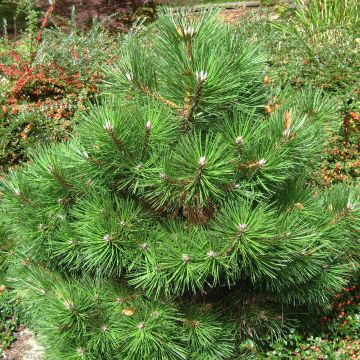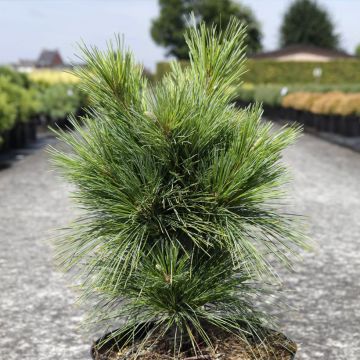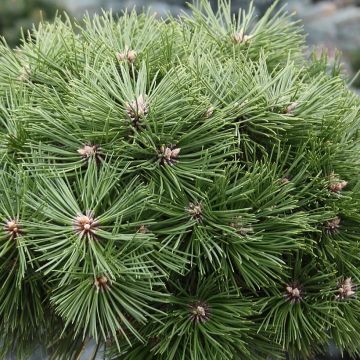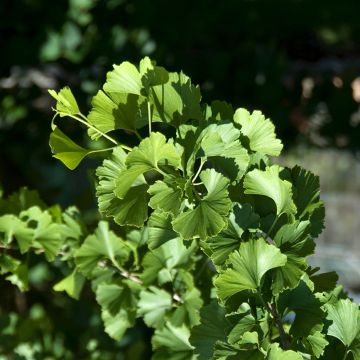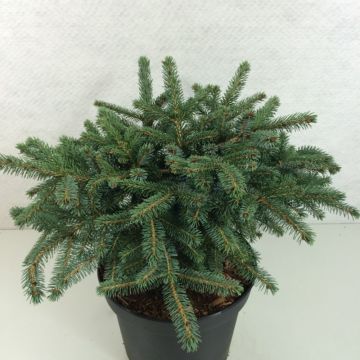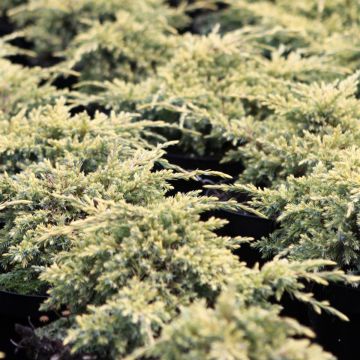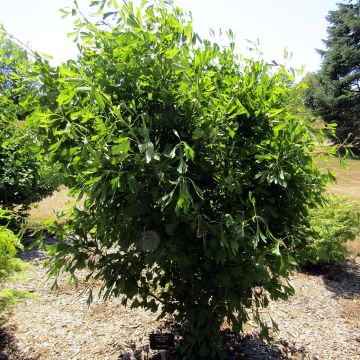

Pinus strobus Secrest - Eastern White Pine
Pinus strobus Secrest - Eastern White Pine
Pinus strobus Secrest
Eastern White Pine, Weymouth Pine, Northern White Pine
This item cannot be shipped to the selected country
Delivery charge from €5.90
More information
Schedule delivery date,
and select date in basket
This plant carries a 24 months recovery warranty
More information
We guarantee the quality of our plants for a full growing cycle, and will replace at our expense any plant that fails to recover under normal climatic and planting conditions.
From €5.90 for pickup delivery and €6.90 for home delivery
Express home delivery from €8.90.
Does this plant fit my garden?
Set up your Plantfit profile →
Description
Pinus strobus 'Secrest' is a dwarf form of the Weymouth pine. Its widely conical habit and its large blue-tinged needles give it an inimitable texture and graphic appearance. Initially rounded in the early years of its life, it then takes on a conical shape. When mature, cylindrical female cones appear, tapered and green, ripening to brown. Of great ornamental value, this slow-growing and compact Weymouth pine can be planted in all gardens, even the smallest, where it thrives quietly in a rather sunny position, whether in a rockery, a flower bed or a large pot. Very hardy, not very demanding in well-drained and not too chalky soil, it is resistant to drought once established.
Pinus strobus, also known as Eastern white pine, Weymouth pine or Lord's pine, is a conifer of the Pinaceae family, native to eastern North America, up to Newfoundland Island in Canada. Its majesty has made it the official emblem tree of the province of Ontario. This forest king is indeed a monumental tree, a gigantic pyramidal Christmas tree reaching 90m (295ft) in height in its natural environment, but currently barely exceeding 45m (148ft) in height due to habitat destruction and extensive exploitation. It is a very hardy species, often planted for reforestation in forests, or as an ornamental tree in large parks. The bark of this bush is smooth, greenish-grey on young subjects, becoming greyish-brown and fissured over time. The lower part of the tree, when mature, shows a whitened bark, hence the vernacular name 'white pine'.
The 'Secrest' variety is characterized by its compact size, its rounded bushy habit, then more upright, taking on a conical shape over the years. Its growth is slow, so that after a few decades, it does not exceed 2m (7ft) in height and 1.50m (5ft) in width. It grows 5 to 10cm (2 to 4in) per year. Its branches are densely covered with shiny, thin, soft and flexible needles, measuring 7 to 12cm (3 to 5in) in length. They are grouped in fives and arranged in tufts, radially around the branches. Their lower surface has two bands of silver stomata (plant breathing cells), giving them a blue to silver sheen. When mature, cylindrical tapered female cones appear, green and ripening to brown. Evergreen bush, it is decorative all year round with its graphic habit and the fluffy green-blue mass it eventually forms over time.
The 'Secrest' Weymouth pine is at home in a contemporary garden with graphic plants as well as in a Japanese garden, but it should not be limited to this use, as pines, being easy to grow, are interesting in all gardens, of any size, bringing a permanent structure of quality, with shimmering reflections and captivating textures. In small spaces, it stands out as a solitary plant and elegantly animates a rockery or a flower bed. In a large container, it becomes a subject that enhances a balcony or terrace. It can be associated with other conifers with colourful foliage and an upright shape to create double contrasts, such as the Chamaecyparis lawsoniana 'Elwood's Gold' or the charming Thuja occidentalis 'Rheingold' with its foliage changing colour throughout the year. It also pairs well with the surprising Japanese maple 'Shishigashira' with its bonsai-like appearance, its tender green foliage crisped and turning scarlet in autumn. To enhance this Japanese style, nothing beats a Chinese "Azalea", the Rhododendron luteum, with its fragrant yellow flowers and superb autumnal colours, or a beautiful Japanese Camellia 'Nobilissima' with its white winter flowering and yellow heart.
Report an error about the product description
Pinus strobus Secrest - Eastern White Pine in pictures
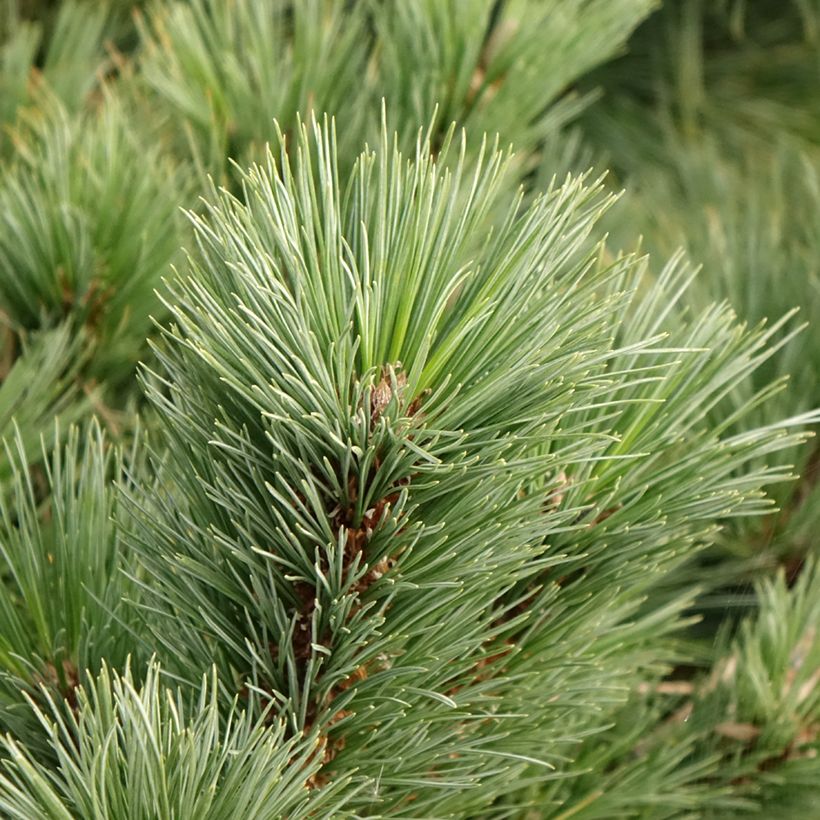

Plant habit
Flowering
Foliage
Botanical data
Pinus
strobus
Secrest
Pinaceae
Eastern White Pine, Weymouth Pine, Northern White Pine
Cultivar or hybrid
Other Pinus - Pine
Planting and care
Pinus strobus 'Secrest' can be planted from September to November and from February to June in regular but deep soil, even clayey, acidic or slightly chalky, but well-drained. It prefers loose and light soils, sandy or loamy, and not very chalky. Choose a sunny or semi-shady spot in a warm climate. Soak the root balls well before planting. Add organic amendment at planting and water generously for the first three years, and in case of prolonged drought. Apply a special conifer fertilizer every year in April and cultivate the soil in summer. This very hardy conifer is not afraid of wind, but it fears waterlogged soils in winter and air pollution. Pruning is not necessary. However, in order to accentuate the compact habit of this bush, it may be possible to perform bud pruning in spring and shorten the year's shoots by up to 2/3 of their length if they are considered unsightly.
Planting period
Intended location
Care
This item has not been reviewed yet - be the first to leave a review about it.
Conifers
Haven't found what you were looking for?
Hardiness is the lowest winter temperature a plant can endure without suffering serious damage or even dying. However, hardiness is affected by location (a sheltered area, such as a patio), protection (winter cover) and soil type (hardiness is improved by well-drained soil).

Photo Sharing Terms & Conditions
In order to encourage gardeners to interact and share their experiences, Promesse de fleurs offers various media enabling content to be uploaded onto its Site - in particular via the ‘Photo sharing’ module.
The User agrees to refrain from:
- Posting any content that is illegal, prejudicial, insulting, racist, inciteful to hatred, revisionist, contrary to public decency, that infringes on privacy or on the privacy rights of third parties, in particular the publicity rights of persons and goods, intellectual property rights, or the right to privacy.
- Submitting content on behalf of a third party;
- Impersonate the identity of a third party and/or publish any personal information about a third party;
In general, the User undertakes to refrain from any unethical behaviour.
All Content (in particular text, comments, files, images, photos, videos, creative works, etc.), which may be subject to property or intellectual property rights, image or other private rights, shall remain the property of the User, subject to the limited rights granted by the terms of the licence granted by Promesse de fleurs as stated below. Users are at liberty to publish or not to publish such Content on the Site, notably via the ‘Photo Sharing’ facility, and accept that this Content shall be made public and freely accessible, notably on the Internet.
Users further acknowledge, undertake to have ,and guarantee that they hold all necessary rights and permissions to publish such material on the Site, in particular with regard to the legislation in force pertaining to any privacy, property, intellectual property, image, or contractual rights, or rights of any other nature. By publishing such Content on the Site, Users acknowledge accepting full liability as publishers of the Content within the meaning of the law, and grant Promesse de fleurs, free of charge, an inclusive, worldwide licence for the said Content for the entire duration of its publication, including all reproduction, representation, up/downloading, displaying, performing, transmission, and storage rights.
Users also grant permission for their name to be linked to the Content and accept that this link may not always be made available.
By engaging in posting material, Users consent to their Content becoming automatically accessible on the Internet, in particular on other sites and/or blogs and/or web pages of the Promesse de fleurs site, including in particular social pages and the Promesse de fleurs catalogue.
Users may secure the removal of entrusted content free of charge by issuing a simple request via our contact form.
The flowering period indicated on our website applies to countries and regions located in USDA zone 8 (France, the United Kingdom, Ireland, the Netherlands, etc.)
It will vary according to where you live:
- In zones 9 to 10 (Italy, Spain, Greece, etc.), flowering will occur about 2 to 4 weeks earlier.
- In zones 6 to 7 (Germany, Poland, Slovenia, and lower mountainous regions), flowering will be delayed by 2 to 3 weeks.
- In zone 5 (Central Europe, Scandinavia), blooming will be delayed by 3 to 5 weeks.
In temperate climates, pruning of spring-flowering shrubs (forsythia, spireas, etc.) should be done just after flowering.
Pruning of summer-flowering shrubs (Indian Lilac, Perovskia, etc.) can be done in winter or spring.
In cold regions as well as with frost-sensitive plants, avoid pruning too early when severe frosts may still occur.
The planting period indicated on our website applies to countries and regions located in USDA zone 8 (France, United Kingdom, Ireland, Netherlands).
It will vary according to where you live:
- In Mediterranean zones (Marseille, Madrid, Milan, etc.), autumn and winter are the best planting periods.
- In continental zones (Strasbourg, Munich, Vienna, etc.), delay planting by 2 to 3 weeks in spring and bring it forward by 2 to 4 weeks in autumn.
- In mountainous regions (the Alps, Pyrenees, Carpathians, etc.), it is best to plant in late spring (May-June) or late summer (August-September).
The harvesting period indicated on our website applies to countries and regions in USDA zone 8 (France, England, Ireland, the Netherlands).
In colder areas (Scandinavia, Poland, Austria...) fruit and vegetable harvests are likely to be delayed by 3-4 weeks.
In warmer areas (Italy, Spain, Greece, etc.), harvesting will probably take place earlier, depending on weather conditions.
The sowing periods indicated on our website apply to countries and regions within USDA Zone 8 (France, UK, Ireland, Netherlands).
In colder areas (Scandinavia, Poland, Austria...), delay any outdoor sowing by 3-4 weeks, or sow under glass.
In warmer climes (Italy, Spain, Greece, etc.), bring outdoor sowing forward by a few weeks.



































